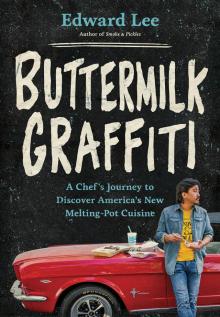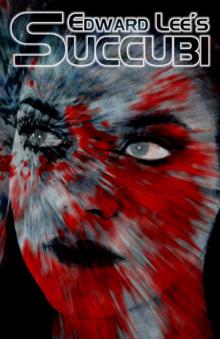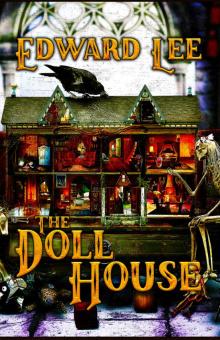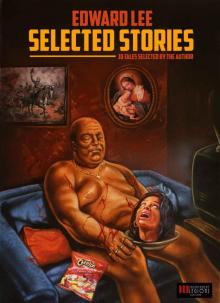- Home
- Edward Lee
Buttermilk Graffiti Page 2
Buttermilk Graffiti Read online
Page 2
It is in those stories that you will find the flavors and textures of who you are, and where you will find your story. If you really want to know someone, you have to eat what he has eaten. The story of your favorite foods is your culinary memoir, not a nameless collection of recipes. And that story will be part of the bigger story we all tell every time we turn on the gas and put on a pot to boil. It is the story of American food.
A Note About the Recipes
You will quickly notice that the recipes in this book are not accompanied by photos.* This was done on purpose. I want you, the reader, to trust your instincts and cook the way I know you are capable of. Having a recipe published with an accompanying photo is a pretty modern invention. We have been following recipes without photos for centuries. When we don’t know what the end result is supposed to look like, the imagination is allowed to roam free and we come up with our own conclusions. Pictures are excellent guides, and can give you a goal to aspire to, but they can also have a negative effect. If you make a dish and it doesn’t look exactly like the photo, you might feel a sense of failure. I don’t want that. None of these recipes are restaurant-style dishes, so the accuracy of plating is less important than the taste of the food. I want you to pay attention to the aromas, flavors, textures, to the feel of the food in your mouth. Don’t worry if what you make doesn’t look good enough to be on the cover of a magazine. If it tastes good, you’ve succeeded.
*Having said that, if you really want to see what the dishes look like, you can find pictures of them at chefedwardlee.com or on Instagram @chefedwardlee.
Chapter 1
Pilgrimage for a Beignet
While the rest of modern society buckles under the weight of its morality, we’ll look to New Orleans to teach us how to live with equal parts temptation, sin, and redemption. Here, excess is a ritual. Indulgence, like the humidity, fills your lungs.
New Orleans is a port city, founded by the French, ruled by the Spanish, bought by the Americans, and culturally impacted by West Africa, Afro-Caribbean descendants, Germans, Sicilians, and Irish. It is the most racially and culturally evolved polyglot city in America, a flawed but seductive utopia. If I lived in New Orleans, I probably wouldn’t last long. There is too much temptation for me. Even today, it seduces the young, from tourists to professional derelicts, all of whom wind up on the banks of the Mississippi searching for their idea of hedonistic abandon. For all the French Quarter’s predictable, groomed debauchery, there is still a dark underbelly that awakens in the wee hours, when the college kids have vomited up their Hurricanes and gone home for the evening. This is the New Orleans I know well. A tawdry hangout on Bienville Street is where I often end up. If Jezebel is behind the bar, she’ll fix you right up. There are still places in New Orleans that don’t exist on any map. These are the places where you can feel the tensions of being in a harlot’s town.
I go to New Orleans once or twice a year, mostly for charitable events. It is one of my favorite cities, and I’ve watched in amazement as it has continued to flourish after Katrina, when many doubted its survival. There are definitely parts of the French Quarter I avoid because they get so congested with tourists, but the lovely thing about New Orleans is that even the tourist traps are great. Galatoire’s and Antoine’s are delectable places to have lunch. And I don’t care how many tourists I have to fend off to get to Acme Oyster House; it is one of the liveliest joints in town. People who don’t know me don’t realize how rare this is: for me to seek out the most touristic spot in town. For example, I wouldn’t be caught dead eating in Times Square, and most deep-dish pizza places in Chicago are just not that good, but I’ll proudly stand in line for a beignet at Café du Monde, which is possibly the biggest tourist attraction in NOLA.
If you haven’t been to Café du Monde, it is a sprawling operation with an indoor café on one side and a large outdoor patio that buzzes under a large green-and-white canopy. It is busy all day. The line starts at the window for beignets and stretches around the patio to the street. You have to get there right when it opens to avoid a long line. I’ve been there over a dozen times, but I can’t tell you what’s on the menu because I always order the same thing: a plate of beignets and a cup of chicory coffee. If it’s too noisy inside the café, I’ll take a walk around Jackson Square. I usually end up by the Mississippi River, where I’ll just gaze out at the water.
Less than a five-minute walk from Café du Monde, you can find a historic home where William Faulkner spent a brief period when he was young. He was here only about a year and half, but it had a lifelong effect on him. He would go on to write some of the most praised Southern Gothic novels of the twentieth century, centered on the rural culture of his Mississippi roots, but it was here in New Orleans where he met his literary mentor, Sherwood Anderson. Faulkner lived at 624 Pirate’s Alley, writing what would become his first novel, Soldiers’ Pay. In one of his later books, he remembered New Orleans as “a courtesan whose hold is strong upon the mature, to whose charm the young must respond.” New Orleans is a city you must visit when you’re young and foolish but return to when you’re wiser and still searching for dreams.
For all Faulkner’s timeless stories, his lasting contribution to literature was not his descriptions of rural Southern life but how he could bend the concept of time. His novels blend memory and desire in ways that defy the rules of chronology or logic. You’re so busy trying to follow the plot that you forget to lose yourself in the beauty of the rambling words spitting across the page like watermelon seeds strewn about a dirt porch after a feast. It is a powerful way to tell a story, even if it confuses the reader on the first go ’round. Some stories are so tragic, so burdened with generations of shame and history and lies, that it’s impossible to tell them in a conventional way.
Some recipes are like that, too. Ask any aging matron for a Creole recipe, and you’ll get a circuitous answer—that is, if she even gives you the time of day. I have been foraging around for a good beignet recipe for years, only to get meager crumbs of anecdotes here and there. Recipes for beignets involve, by and large, the same ingredients: flour, fat, leavening, and a deep fryer. It’s the technique that differs. Every person I ask has a personal technique he swears by. It’s not that one is better than another. I’ve tried half a dozen techniques, and all the recipes pretty much come out tasting the same. The recipe is easy. I can tell you how to make bei-gnets in sixty seconds. But like any good tale, the point of it is not what happens at the end; it’s how you get there. Every time I hear a story about the beignet, it’s a little bit different. And it’s that narrative that makes the taste more satisfying. It’s memory and love with a pinch of hyperbole.
The story of my beignet is tied to Faulkner. I was a senior at NYU, taking a class on Hemingway and Faulkner. As part of my thesis paper, I made a trip to New Orleans. Conveniently, Mardi Gras was right around the corner. It was the first time I’d traveled south of Virginia and the first long road trip of my youth. I convinced a friend to join me on my pilgrimage to Pirate’s Alley, where I found an uninspired exhibit: a typewriter sitting on the desk where Faulkner apparently got drunk and disturbed the neighbors. The clerk gave me a souvenir bookmark. And that was it. My friend and I arrived on a Saturday, met two girls (on whom we’d spent all our money by Sunday), and come Monday, we were broke. We would be leaving on the morning of Fat Tuesday, with just enough gas money to get home, but before we left, I had my first beignet ever, at Café du Monde. I stood in line with the other tourists, sweating alcohol. My friend was in the car leaning on the horn. He’d had enough of New Orleans. He blamed me for the girls who’d cost us all our money; he wasn’t in the mood to talk. I got back in the car, and he pulled away. Slowly, I chewed through a bag of beignets while powdered sugar gathered on my chest. We didn’t start talking again until we were almost to Atlanta. It didn’t matter to me: I was thinking about Brandi the whole time.
I met Brandi in New York City in 1992. To pay for my
college tuition at NYU, I worked at the Big Apple Diner, on the corner of Twenty-Eighth and Madison. I knew my way around a kitchen, so a diner gig was easy money for me. The breakfast shift was all I had time for. After all, I had classes to attend. Every morning, I’d arrive at work around 4:30 and light the ovens’ pilot lights. I’d mix the pancake batter and muffin mixes. Next I’d drain the sliced potatoes from the night before and start chopping vegetables for the home fries. I’d receive the bread and bagel deliveries, and bring stacks of eggs to room temperature in preparation for the breakfast rush that started at 6:15 a.m. on the dot. Later, I’d show up for my Latin class wearing a T-shirt stained with margarine and blueberry muffin mix. Everyone else in the course came from private high schools and were on their way to law school. I had to recite my conjugations while enduring what I was sure were their glances of pity and revulsion. I started to bring a clean oxford shirt to change into before class.
The Big Apple Diner could never keep a breakfast cook. I soon understood why. Yes, I did most of the prep work alone, but the work wasn’t so bad. It was the neighborhood I hated. Today it’s called NoMad, and the blocks are lined with high-end restaurants and boutique hotels, but there was a time when those streets were so bad that even the police stopped patrolling them. For decades, the neighborhood between Greeley Square and Madison Square Park was a large swath of no-man’s-land littered with defunct luxury hotels. If you listened closely, you could hear the ghost of the last proud bellman dropping a shiny coin in the pocket of his frayed uniform. In the early twentieth century, this was the opulent Theater District, and these lavish hotels were the toast of the town. When the Theater District moved farther north, the hotels floundered, and by the 1970s, they were mostly bankrupt and evacuated. The city had the brilliant idea of converting them into low-income housing for the homeless and mentally ill, and they became known as welfare hotels. The Martinique, which once boasted Circassian walnut wainscoting and gold tapestry panels, became an incubator of drug selling and prostitution, its walls teeming with rats and roaches. Homeless families lived in squalor and fear as drug dealers, pimps, and gangs took over the neighborhood. There were other hotels, places with lofty names such as the Prince George, the Latham, the Carter. If you lived in New York City at the time, you avoided this pit of human travesty. For decades, the city turned its gaze away from the problems there, while its downtrodden residents suffered like animals.
The neighborhood wasn’t so bad during the day. There were enough office workers walking about to give the streets a sense of normalcy. But in the hours before dawn, it was a lawless place, dangerous and unpredictable. In just a few weeks of working at the diner, I had gotten mugged, threatened with death, spat on, and accosted with a prosthetic leg while walking to work. Inside the restaurant, things were better, except when vandals threw bricks at the windows or tried to steal my bread delivery.
I got to know a lot of the prostitutes who ate there; we called them hookers back then. They came into the diner at around 5:00 a.m., looking for an egg sandwich or a hot cup of coffee with a fistful of sugar in it. We used to open early, but stopped because of all the trouble the women brought. Some were strung out, some were just thieves, and a few even tried to turn tricks in the bathroom. So we kept the front door locked until 6:00 a.m., when the first orange light of dawn sent the girls home. Still, a few of them were nice. They were usually young mothers just trying to make enough cash to get to a better place. If it was a slow night, I would buy their coffee or throw some bacon into their sandwiches without anyone knowing. The kitchen was open to the dining room, so I could see who was at the front door. If I knew the girl, I’d let her in. The owners never came in until about 7:00 a.m., so I was really the only one calling the shots until then.
Brandi was a cool girl. She always paid her tab and never made a fuss. She smelled like plastic carnations and bubble gum. When she spoke, her accent was Gone with the Wind meets New Jack City. She always braided her hair off to one side, which made her look young, about twenty-one, which was my age at the time. I found it unfair that I was in college while she was trying to raise a kid.
Brandi always left the diner before the office workers came in for the morning rush. She always ordered an egg sandwich, and I’d bump it up to a deluxe, with two eggs, cheese, and bacon. Sometimes, I’d even throw a cheese Danish into her bag. The morning waitress would catch me giving away food, but I didn’t care. They couldn’t fire me: there was no one else who wanted to work the morning shift.
Brandi would sit at the counter while I prepped for breakfast. We had little in common, so we talked about trivial things, such as movie stars and the weather. One day, while I was wrapping up her egg sandwich, she asked me if I was a virgin. I wasn’t, but I found her question so aggressive that I blushed. “I knew you was a virgin,” she said. After that, she called me the Virgin. It was condescending but playful. Every time she said it, there was an unspoken invitation. After all, I knew what she did for a living.
Brandi always checked the bag of food I handed to her before she left, to see what was in it. She’d wink at me and wave good-bye. I liked when she did that. I let her use that nickname, too. Sometimes, when she said it, I forgot what she did for a living and she was just another girl being silly, flirting with me. And that broke my heart every time.
Around that time, I started trying new things in the kitchen, nothing too advanced, but enough to keep my mind from going numb. I stopped using the diner’s instant pancake mix and made the batter from scratch. I made lemon–poppy seed bread and banana-walnut bread. The things I made were selling nicely, and that encouraged me to expand the diner’s breakfast offerings. One morning, while I was trying my hand at fresh doughnuts, Brandi happened to be around. I gave her a warm, odd-shaped doughnut just out of the deep fryer. Her eyes lit up.
“This is good. Reminds me of New Orleans,” she said.
“Is that where you’re from?”
“Yeah. You ain’t lived till you been dere and had a beignet.”
“A what?” I asked her.
“A beignet.”
“What’s that?”
“It’s like this,” she said, holding up the doughnut I’d made her, “but sweeter and warmer and better.”
“And they only have them in New Orleans?”
“Only.”
“I’ll make one for you next time.”
“You don’t know how, Virgin. It’s only dere. It tastes so good. You have to go to Café du Monde and have the real one.”
“And what’s it called again?”
“A beignet.”
“How do you spell it?”
“I don’t know. You the college boy.”
“Say it again?”
“A beignet.”
“A ben-what?”
“A bayn-YAY, mutherfucker. Something wrong wit yo ears?”
One day, Brandi stopped coming to the diner—no good-bye. This was typical: the working girls never stuck around too long. It was 1993, the serial killer Joel Rifkin had finally been arrested, and the city was under pressure to clean up the streets. Even the welfare hotels were shutting down. Still, I thought that Brandi and I had had enough of an acquaintance that she would at least have said good-bye. Maybe I wasn’t that important to her. I knew in my heart that nothing bad had happened to her; she was too smart for that. I figured she’d moved on to a better situation. But it would have been nice for her to have let me know, so I wouldn’t worry. Then again, what if she had come to say good-bye? Would we have exchanged numbers and kept in touch? Maybe she had been nice to me all that time just because of the free food. Still, I missed her—and I promised myself that I would take her advice and go to New Orleans one day and have a real beignet.
I think about Brandi every time I go to Café du Monde. I have this crazy notion that I might even run into her one of these times. I like sitting outdoors even when it is deathly humid.
I’ll walk from my hotel to the French Quarter, under the banana trees, enjoying the smell of piss being sprayed off the streets. Most of the locals tell me to go to Morning Call for coffee, but I like coming to the French Quarter early in the morning, when it isn’t overrun with tourists. On this particular day, I’m running a little late. When I get there, it’s 9:00 a.m., and the line is already stretching out onto the street. My head feels as if a small pea were bouncing around in my empty skull, and the river smells fetid. All I want is a good beignet.
There are many other places that sell beignets in the French Quarter but none as good as Café du Monde. A good beignet should have a pillow of hot air inside that is released when you take a bite; it should not be hollow, or dense with holes. The powdered sugar should get all over your upper lip and float into your nose such that if you make the mistake of inhaling while taking a bite, you’ll wind up coughing up powdered sugar. I like foods that punish the uninitiated.
The history of the beignet varies depending on whom you ask. When you research it, it is impossible not to come across its once more famous cousin, calas. The roots of the calas (sometimes referred to as a beignet de riz) can be traced back to Africa, where the calas is called togbei in Ghana, puff puff in Nigeria, and mikate in Congo, and where it is made, again depending on whom you ask, from some form of rice or cassava. Over time, the calas made its way to New Orleans, to become the dominant pastry served on the streets by Creole women. New Orleans food writer and radio host Poppy Tooker tells the story of how early twentieth-century prostitutes would dress up for Carnival and go from door to door to be served calas. Over time, refined wheat flour and the French influence mutated the calas into the popular beignet we know and love today.

 In the Year of Our Lord 2202
In the Year of Our Lord 2202 The Minotauress
The Minotauress Terra Insanus
Terra Insanus The Stickmen
The Stickmen Flesh Gothic by Edward Lee
Flesh Gothic by Edward Lee Family Tradition
Family Tradition You Are My Everything
You Are My Everything The Backwoods
The Backwoods The Teratologist
The Teratologist Smoke and Pickles
Smoke and Pickles Buttermilk Graffiti
Buttermilk Graffiti Dahmer's Not Dead
Dahmer's Not Dead Quest for Sex, Truth & Reality
Quest for Sex, Truth & Reality The Innswich Horror
The Innswich Horror Brides Of The Impaler
Brides Of The Impaler Goon
Goon Trolley No. 1852
Trolley No. 1852 Sacrifice
Sacrifice Monster Lake
Monster Lake Succubi
Succubi Lucifer's Lottery
Lucifer's Lottery Monstrosity
Monstrosity The House
The House The Dunwich Romance
The Dunwich Romance Operator B
Operator B Bullet Through Your Face (improved format)
Bullet Through Your Face (improved format) Grimoire Diabolique
Grimoire Diabolique Room 415
Room 415 The Messenger (2011 reformat)
The Messenger (2011 reformat) Incubi
Incubi The Black Train
The Black Train House Infernal by Edward Lee
House Infernal by Edward Lee City Infernal
City Infernal Creekers
Creekers The Haunter Of The Threshold
The Haunter Of The Threshold Mangled Meat
Mangled Meat The Doll House
The Doll House Header 2
Header 2 Bullet Through Your Face (reformatted)
Bullet Through Your Face (reformatted) Header 3
Header 3 Infernal Angel
Infernal Angel Pages Torn From a Travel Journal
Pages Torn From a Travel Journal Edward Lee: Selected Stories
Edward Lee: Selected Stories The Bighead
The Bighead The Chosen
The Chosen